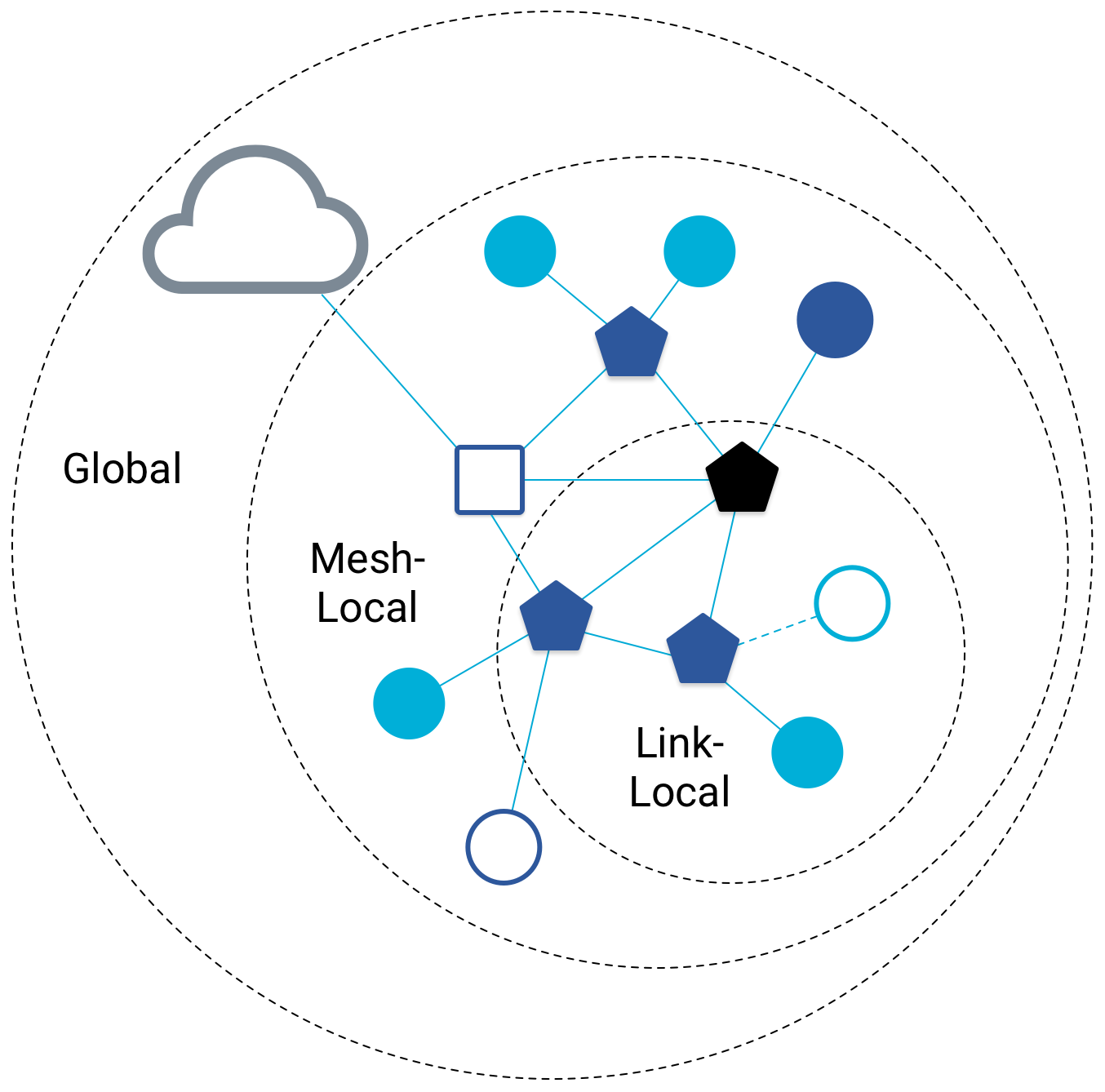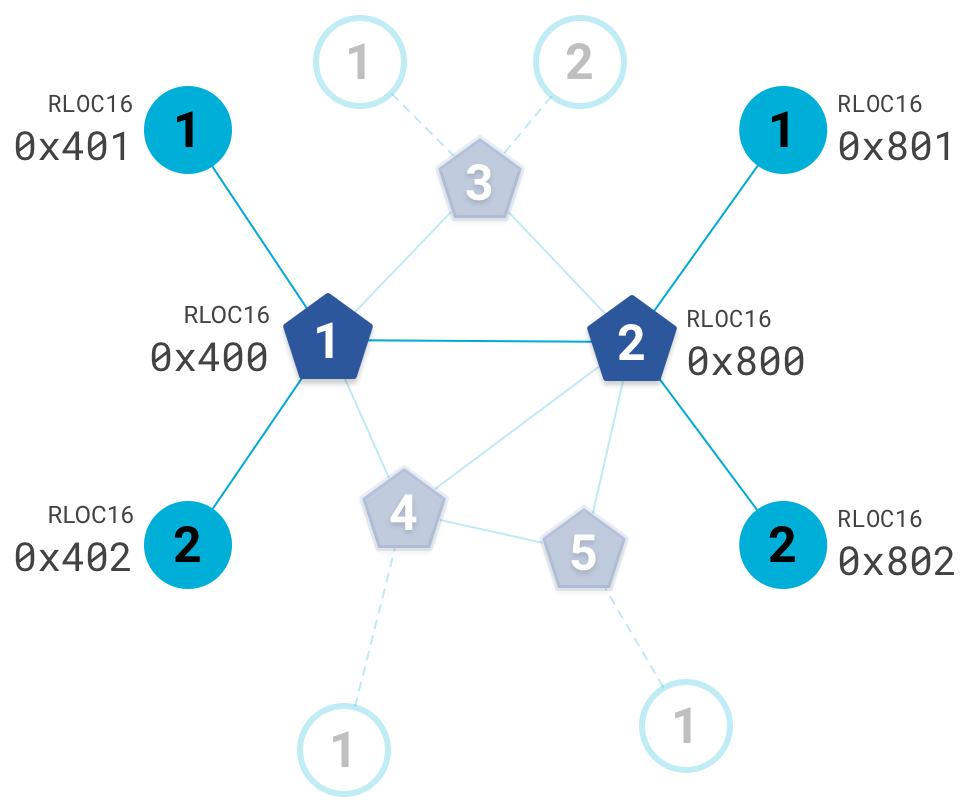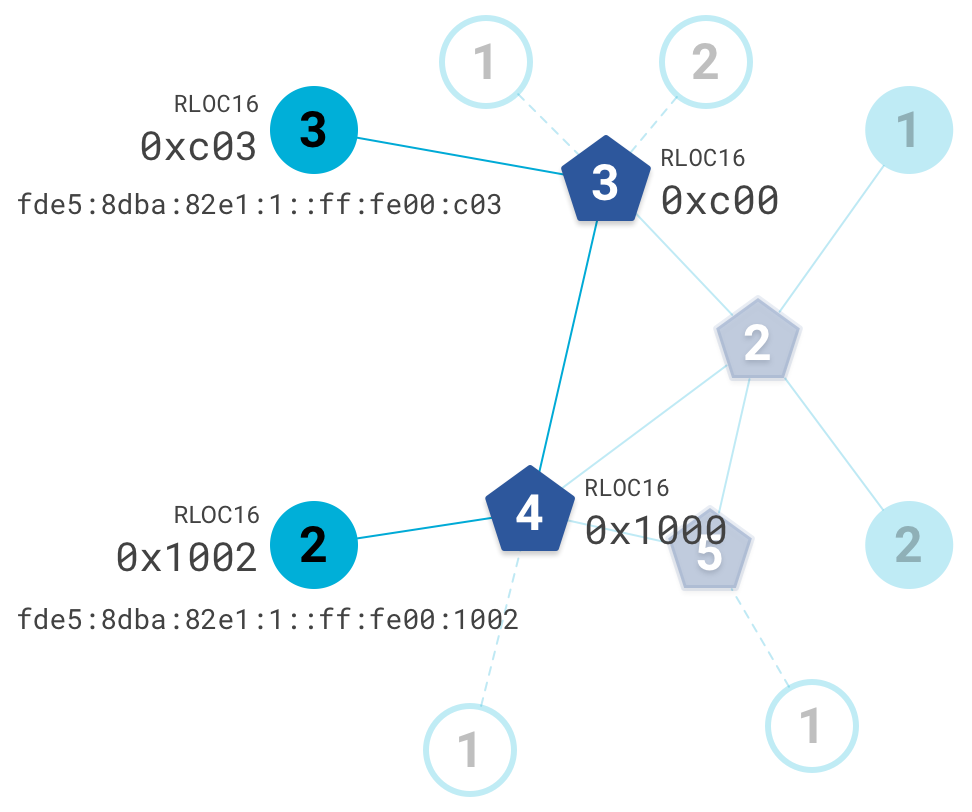Let's take a look at how Thread identifies each device in the network, and what types of addresses they use to communicate with each other.
Scopes

There are three scopes in a Thread network for unicast addressing:
- Link-Local — all interfaces reachable by a single radio transmission
- Mesh-Local — all interfaces reachable within the same Thread network
- Global — all interfaces reachable from outside a Thread network
The first two scopes correspond to prefixes designated by a Thread network.
Link-Local have prefixes of fe80::/16, while Mesh-Local have prefixes of
fd00::/8.
There are multiple IPv6 unicast addresses that identify a single Thread device. Each has a different function based on the scope and use case.
Before we detail each type, let's learn more about a common one, called the Routing Locator (RLOC). The RLOC identifies a Thread interface, based on its location in the network topology.
How a Routing Locator is generated
All devices are assigned a Router ID and a Child ID. Each Router maintains a table of all their Children, the combination of which uniquely identifies a device within the topology. For example, consider the highlighted nodes in the following topology, where the number in a Router (pentagon) is the Router ID, and the number in an End Device (circle) is the Child ID:

Each Child's Router ID corresponds to their Parent (Router). Because a Router is not a Child, the Child ID for a Router is always 0. Together, these values are unique for each device in the Thread network, and are used to create the RLOC16, which represents the last 16 bits of the RLOC.
For example, here's how the RLOC16 is calculated for the upper-left node (Router ID = 1 and Child ID = 1):

The RLOC16 is part of the Interface Identifier (IID), which corresponds to the last 64 bits of the IPv6 address. Some IIDs can be used to identify some types of Thread interfaces. For example, the IID for RLOCs is always in this form:
0000:00ff:fe00:RLOC16
The IID, combined with a Mesh-Local Prefix, results in the RLOC. For example,
using a Mesh-Local Prefix of fde5:8dba:82e1:1::/64, the RLOC for a node where
RLOC16 = 0x401 is:

This same logic can be used to determine the RLOC for all highlighted nodes in the sample topology above:

However, because the RLOC is based on the location of the node in the topology, the RLOC of a node can change as the topology changes.
For example, perhaps node 0x400 is removed from the Thread network. Nodes
0x401 and 0x402 establish new links to different Routers, and as a result
they are each assigned a new RLOC16 and RLOC:

Unicast address types
The RLOC is just one of many IPv6 unicast addresses a Thread device can have. Another category of addresses are called Endpoint Identifiers (EIDs), which identify a unique Thread interface within a Thread network partition. EIDs are independent of Thread network topology.
Common unicast types are detailed below.
Link-Local Address (LLA) |
|
|---|---|
| An EID that identifies a Thread interface reachable by a single radio transmission. | |
| Example | fe80::54db:881c:3845:57f4 |
| IID | Based on 802.15.4 Extended Address |
| Scope | Link-Local |
| Details |
|
Mesh-Local EID (ML-EID) |
|
|---|---|
| An EID that identifies a Thread interface, independent of network topology. Used to reach a Thread interface within the same Thread partition. Also called a Unique Local Address (ULA). | |
| Example | fde5:8dba:82e1:1:416:993c:8399:35ab |
| IID | Random, chosen after commissioning is complete |
| Scope | Mesh-Local |
| Details |
|
Routing Locator (RLOC) |
|
|---|---|
| Identifies a Thread interface, based on its location in the network topology. | |
| Example | fde5:8dba:82e1:1::ff:fe00:1001 |
| IID | 0000:00ff:fe00:RLOC16 |
| Scope | Mesh-Local |
| Details |
|
Anycast Locator (ALOC) |
|
|---|---|
| Identifies a Thread interface via RLOC lookup, when the RLOC of a destination is not known. | |
| Example | fde5:8dba:82e1:1::ff:fe00:fc01 |
| IID | 0000:00ff:fe00:fcXX |
| Scope | Mesh-Local |
| Details |
|
Global Unicast Address (GUA) |
|
|---|---|
| An EID that identifies a Thread interface on a global scope, beyond a Thread network. | |
| Example | 2000::54db:881c:3845:57f4 |
| IID |
|
| Scope | Global |
| Details |
|
Multicast
Multicast is used to communicate information to multiple devices at once. In a Thread network, specific addresses are reserved for multicast use with different groups of devices, depending on the scope.
| IPv6 Address | Scope | Delivered to |
|---|---|---|
ff02::1 |
Link-Local | All FTDs and MEDs |
ff02::2 |
Link-Local | All FTDs |
ff03::1 |
Mesh-Local | All FTDs and MEDs |
ff03::2 |
Mesh-Local | All FTDs |
You might notice that Sleepy End Devices (SEDs) are not included as a recipient in the multicast table above. Instead, Thread defines link-local and realm-local scope unicast prefix-based IPv6 multicast address used for All Thread Nodes, including SEDs. These multicast addresses vary by Thread network, because it is built on the unicast Mesh-Local prefix (see RFC 3306 for more details on unicast-prefix-based IPv6 multicast addresses).
Arbitrary scopes beyond those already listed are also supported for Thread devices.
Anycast
Anycast is used to route traffic to a Thread interface when the RLOC of a
destination is not known. An Anycast Locator (ALOC) identifies the location of
multiple interfaces within a Thread partition. The last 16 bits of an ALOC,
called the ALOC16, is in the format of 0xfcXX, which
represents the type of ALOC.
For example, an ALOC16 between 0xfc01 and 0xfc0f is reserved for DHCPv6
Agents. If the specific DHCPv6 Agent RLOC is unknown (perhaps because the
network topology has changed), a message can be sent to a DHCPv6 Agent ALOC to
obtain the RLOC.
Thread defines the following ALOC16 values:
| ALOC16 | Type |
|---|---|
0xfc00 |
Leader |
0xfc01 – 0xfc0f |
DHCPv6 Agent |
0xfc10 – 0xfc2f |
Service |
0xfc30 – 0xfc37 |
Commissioner |
0xfc40 – 0xfc4e |
Neighbor Discovery Agent |
0xfc38 – 0xfc3f0xfc4f – 0xfcff |
Reserved |
Recap
What you've learned:
- A Thread network consists of three scopes: Link-Local, Mesh-Local, and Global
- A Thread device has multiple unicast IPv6 addresses
- An RLOC represents a device's location in the Thread network
- An ML-EID is unique to a Thread device within a partition and should be used by applications
- Thread uses multicast to forward data to groups of nodes and routers
- Thread uses anycast when the RLOC of a destination is unknown
To learn more about Thread's IPv6 addressing, see sections 5.2 and 5.3 of the Thread Specification.
Check your understanding
ff03::2
multicast address. What does this tell us about the device?ff03::2 multicast address. They do so in the Mesh-Local
scope.